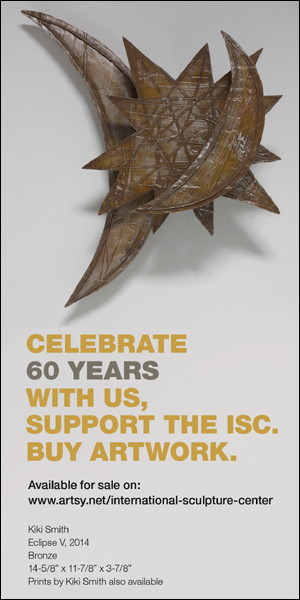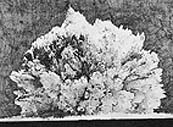
During the past 20 years, the notion of “imagination” has been given short shrift. With very few notable exceptions, a fast scan through the art magazines of the past two decades leaves the impression of rigid categories of work produced by legions of practitioners any one of whom could be substituted for the other without a marked change in outcome. Risk-taking and the imagination are bound within learned patterns and conventions; these characteristics of the creative process have been increasingly repressed by the art world’s proprieties and rules of presentation. Artists have come to be viewed as agents without true instrumentality, vehicles through which the culture practices its logic and performs its prohibitions.
Heide Fasnacht has never subscribed to this kind of passivity; she belongs instead to the rather small ranks of artists whose work represents a triumph of individual imagination over the repressions of style and fashion. Fasnacht’s work is an amalgam of intelligence, humor, and craft representing nothing less than a grand attempt to give poetic form to knowledge. Her work is always handsome, elegant even; yet it seems remote from its own appearance. This is work more engaged with itself than with the viewer; its appearance seems more a side effect of its subject matter than a strategic attempt to attract.
Fasnacht’s interest in a range of phenomena has led her to read widely from an eclectic mix of interrelated scientific literature. Rorschach testing, R.L. Solso’s cognitive research on rapid eye movement, and astronomer Sir William Herschel’s incorrect 19th-century charts of the Milky Way—these sources provide a foundation for Fasnacht’s interest in creating metaphorical guides to the familiar and arcane territories of the universe and human psychology. Her work is neither duplication nor critique of impersonal scientific technique but a quirky, humorous attempt to make allegory from information. Like Jorge Luis Borges’s obsessed mapmaker, Fasnacht carves out patterns of order from phenomena too large and complex to understand on any level other than the metaphorical.
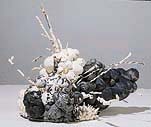
While black and white photographs and maps of stars, eye-scans, and continents have provided a visual format for much of Fasnacht’s imagery, her aesthetic is derived from the art of the ’70s. Artists of this period engaged in a phenomenological examination of experience and of the notion of objectivity. The act of perception itself was emphasized and distinguished from the subject of observation. Focus was centered on the process of observation rather than merely the observed thing. Similarly, Fasnacht attempts detachment from the “idea” of sculpture while at the same time trying to be receptive to the phenomena that have attracted her.
These interests and approaches represent a highly conflicted relationship with abstraction. Fasnacht’s work appears “realistic”; its imagery is drawn from “factual,” “scientific” sources such as maps and photographs, all supposed representations of reality. Her current use of ready-made images is a major change within a body of work that was overtly abstract in the past. Yet for all its roots in fact, her imagery has more of a cartoony than a realistic flavor—a form that invites fantasy and the slippage of meanings. While the work is formally true to its roots in observed phenomena, it performs a clever reversal in the way it reveals and emphasizes the abstraction concealed in a realistic image. Her art achieves its effect by calling attention to the split experience fundamental to modern life—the separation between the retinal and the conceptual, the immediately perceived and the slowly understood, the instinctual and the learned. The viewer experiences her work as a contradiction because of the tension between the coolly distanced, analytical sources of the images and their dense, expressionistic appearance. Each of her objects is layered with intersecting stories and allusions that seem to create systems of order while at the same time undermining any notion of fixed relationships.
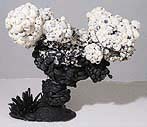
Fasnacht’s materials and processes of fabrication are chosen because of their particular visual qualities. The way they are combined results in an idiosyncratic object with a highly specific visual texture that bears a rich mixture of memory, association, and emotional charge. Although much of what she does is based on an analysis of systems, the work flouts the notion of systems, the idea of fixity and rules, suggesting the inadequacy of ideas of coherence. It introduces an alternative to the known order of things, and is also a criticism of that order.
Over the course of a 20-year career, Fasnacht’s material choices have been integral to her melding of structure and meaning. As her interests in particular phenomena became more theoretical in nature, the physiognomy of her work followed suit: metaphor gradually replaced physicality. For the past three years, Fasnacht has been producing a body of work that is her most dematerialized to date. This current work borrows its form from stop-action photography of natural phenomena involving explosive forces. She finds these images in text books from the ’40s and ’50s, black and white illustrations saturated with the aura of faith, hope, and excitement that permeated the sciences at that time. Though the phenomena that attract her are basically unrelated, all involve wind, air, and movement through space. The work’s composition is drawn from the physics of explosion, a ready-made form that allows expression of Fasnacht’s deeply psychological narrative. Controlled disorder, anxiety, the goofy insecurity of objects have always been the subtext of Fasnacht’s work. In the “explosion” series, cataclysmic movements of air and particulate matter are transformed through the way Fasnacht relates them to the natural functions and experiences of the body.
The objects begin as large, intricately detailed black and white drawings. A drawing such as Bomb (1997) is based on a number of photographs of similar events; it is a kind of compendium of related occurrences rather than a rendering of one particular moment in time. The drawing functions as the maquette for the sculpture, in a way that allows Fasnacht to analyze and refine aspects of the phenomena that most interest her. The black and white of the drawings and their original sources dictate the color choice for the sculpture.

Sneezes, volcanic eruptions, geysers, and bomb blasts are either miniaturized or enlarged from the drawings. Little Sneeze (1997) is one of the first of this series. It is mounted on the wall in such a way that the sneeze appears as if it were erupting from a giant mouth hidden just inside the sheet rock. This sneeze is composed from minute balls of black or white polymer clay strung patiently on steel wires radiating vortex-like from a centralized core. Like her other objects, it is based on a stop-action photograph of a sneeze-in-progress, complete with delicate spray of spit. The image is humorous and also beautiful; there is a hysterical tension between the scale of this object and the viewer’s personal experience of it.
A more recent work, Eruption (1998) miniaturizes a volcanic eruption, presenting it as a tabletop souvenir of a catastrophe. Also composed from balls of black and white polymer clay adhered to steel wires, this piece is Fasnacht’s most figurative, with an exaggerated Betty Boop-like cloud form standing with hip cocked atop a conelike platform. It is because of this figurative association that the piece appears miniaturized; in the sense that the piece is considerably smaller than “human-scale,” Fasnacht uses the idea of the miniature to create a scale of fantasy. At small scale, all immensities are controllable, comprehensible; an entire industry catering to children is based on this simple fact. Fasnacht’s baby volcanic eruption is a distant relative of the little accessories sold to model train owners so that they can recreate a realistic landscape for their trains to pass through. Eruption combines Disney’s “gee-whiz ain’t nature grand” sentimentality with Fasnacht’s subversive humor: the jokiness of the piece is emphasized by the contrast between the big, white, breasty, top-heavy cloud of smoke and the slightly smaller, black cone of a base. The point of the joke is delicately sandwiched between these two weights: the thin, tenuous, waistlike plume emerging from the “crater.” If the miniature can be seen as a metaphor for interiority and the gigantic as an exaggeration of the exterior, this recent work of Fasnacht falls somewhere in between. Its intimate scale and detailed surface invite fantasy; at the same time, the sense that the image has been enlarged from a photograph makes it apparent that this object is not realistic—that it is, instead, something else, something imaginary, invented, thoroughly unreal. This dissonance between what the viewer believes is reality and what is presented in its place, invites a more ironic and humorous reading.
This sense of linkage between the intimate and the grotesque has long been present in Fasnacht’s work. Her earliest exhibited work was made from laminated wood, its surfaces worked in various ways so that the physical transformation of the material was emphasized by the way the surfaces were treated. This group of objects included smoothly sanded combinations of cones and ovals placed at tilted axes; and raw, distressed cocoons of wood. Oculama (1989) is typical of this body of work. These fantastical, large structures suggest the relationships of atoms and certain aspects of new theories in particle physics: quarks and the like. Typically, each object demonstrates its generating conception as well as the physical labor required to produce it.
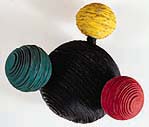
Layering, laminating, sewing together: additive processes have always been integral to Fasnacht’s work. The way in which the material is worked is always an aspect of the nature of that material, her process is always in balanced dialogue with material. Fasnacht has used laminated rubber to create big, floppy forms, often suspended, that emphasize a relationship with the human body. These wall-hung and free-standing pieces are made from layered, glued, and riveted sheets of conveyor belt rubber. In a piece like Terra Lingua, Fasnacht emphasized the skinlike nature of the material which underlined the relationship of her forms to those of the body. In subsequent work like Pony Tail Girls, Fasnacht laminated layers of colored rags together to create bilaterally symmetrical forms which duplicated the ink block patterns of the Rorschach test.
In many ways, Fasnacht is a traditional object maker; her work occupies space with all the formal considerations of sculpture’s presence. At the same time, she approaches sculpture as an arena for the exploration of ideas, an open system that’s perpetually expanding. In this way, she is able to provoke questions about meaning and content: her work not only provides an experience of art, it also questions the nature of that experience.
Marcel Duchamp’s secretive search for the meaning of art culminated in the notion of the aesthetic as an illuminating erotic gas. Duchamp saw the interaction between viewer and object as a performance of mutual attraction, sexual in nature: a menage a trois in which the absent artist seduces the viewer via the agency of a third party, the art object. The object exudes some kind of pheromone or attractant—a love gas of sorts.
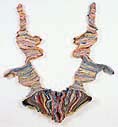
Fasnacht’s work subscribes to this Duchampian notion. Her work is oddly sexy, obliquely invoking the felt presence and experience of the body without ever showing one. The concreteness of Fasnacht’s imagery is a prop, a pretext for dreaming and free-association. Her work perceives the mechanics of nature as analogous to sensations experienced by the body: the eruption of a volcano is associated with the force of orgasm, the propulsive force of a sneeze as akin to the centrifugal force exhibited by a tornado. The nature of her seduction is indirect, achieved through story-telling, invocation, and transference. Fasnacht’s work responds to the viewer, gives up information, memory impressions. More than mere arousal occurs. Interaction with Fasnacht’s work dramatizes the interrelationships in the world at large between signifier and signified, code and content, as well as between artist and viewer.
Kathleen Whitney is a sculptor and critic who lives in New Mexico.



